Samsung Galaxy S5 Review
Samsung Galaxy S5 Review
Review Update: What's the S5 like on Android 5.0 Lollipop and is it still worth considering?

Sections
- Page 1 Samsung Galaxy S5 Review
- Page 2 Screen and Video Playback Review
- Page 3 Android 4.4 Software, TouchWiz Interface Review
- Page 4 Benchmarks and Performance Review
- Page 5 Camera App and Modes Review
- Page 6 Samsung Galaxy S5: Camera Hardware Explained Review
- Page 7 Camera Image Quality and Video Review
- Page 8 Battery Life and Verdict Review
Verdict
Pros
- Fantastic screen
- Still one of the best cameras around
- Now updated to Android 5.0 Lollipop
- Update has improved fingerprint sensor
- Better battery life than S6
- Has microSD and water resistance
Cons
- Not the prettiest of 2014 phones
- Processor still decent, but behind the times
Key Specifications
- Review Price: £499.99
- 16-megapixel camera
- 5.1-inch 1080p Super AMOLED screen
- Android 4.4 with TouchWiz
Update by Jon Devo
How does the Galaxy S5 compare to the latest phones?
When’s the best time to buy a flagship phone? When it gets replaced by a new flagship phone, of course. Following on from the announcement of the Galaxy S6 and Galaxy S6 Edge, the Samsung Galaxy S5 has been given a second wind, courtesy of an update to Android 5.0 Lollipop. Does this update give the Galaxy S5 a new lease of life? Let’s take a look at what improvements have been added with the Android 5.0 update.
Android 5.0 Lollipop on the Galaxy S5
Aesthetically, the Galaxy S5 Android 5.0 Lollipop with its TouchWiz twist is a sophisticated and modern affair, with bold colours and cleaner fonts, icons and menus. Some may feel that this simplification has dumbed down the Galaxy S5, though. We definitely agree that the phone doesn’t quite feel as ‘classy’ or business-like since it received the Lollipop update.
Related: Amazon Prime Day 2019
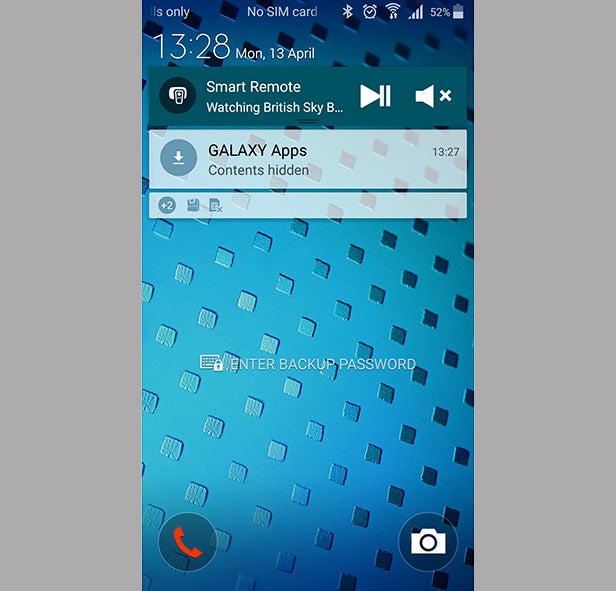
Samsung has reined in some of Lollipop’s flavour though, such as toning down some of the new ‘cartoony’ menu animations and avoiding the big bright tiles that dominate the dial screen of pure Lollipop devices. These changes may have been a step too far for some of the Galaxy S5’s devout crowd, but the Galaxy S5’s menus are noticeably snappier following from the update.
Notifications and settings receive the most obvious changes. Notifications now appear as white tabs that can be accessed in a drop down menu and cleared if needed. If you delve into notifications settings you can now activate/deactivate the notifications of apps on an individual basis, which is handy.
SEE ALSO: Samsung Galaxy S4 VS S5 VS S6: Which is the right upgrade for you?
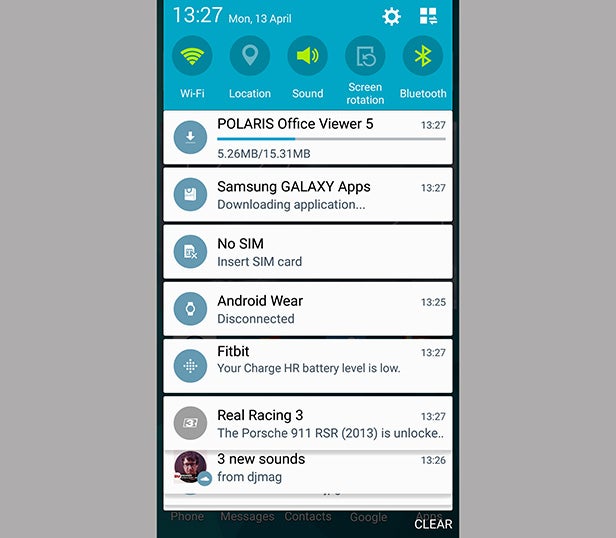
Quick settings and Samsung Smart Remote are also available with the screen locked, giving easy access to useful functions such as quick connect, brightness control and wireless connectivity. Other applications, such as playing media and the camera, can still be used with the screen locked as well. None of this is a great departure from the features we had with Android 4.4 KitKat, but the tweaks seem to make for a smoother experience.
The home screen is rendered with five boxy apps along the bottom rather than the playful rounded ones that cleaner Android Lollipop installs have. Instead of a rounded central applications launcher, the S5 has a square one that’s fixed in the bottom right corner. It’s another example of where the Galaxy S5’s Lollipop has been altered by TouchWiz.
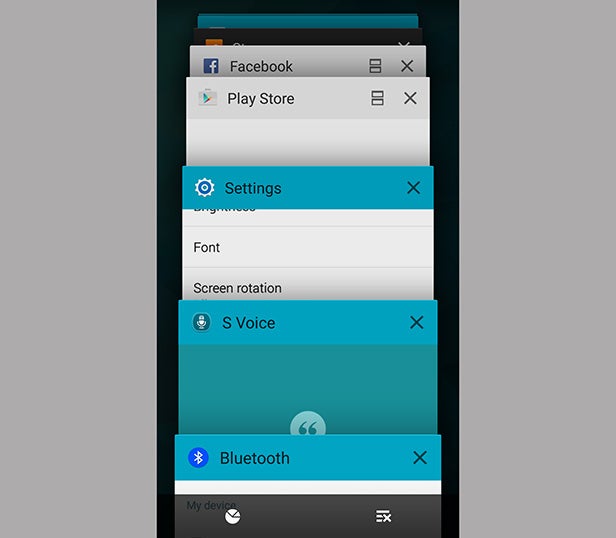
Samsung has ditched its recent apps view for the Lollipop Rolodex style. We’ve seen some negative comments about this move, but it was one of the Android 5.0 features that we liked and we feel it works well on the Galaxy S5. It’s good to see that the TouchWiz Multi Window is still on the S5, though.
Fingerprint scanner improved
The fingerprint scanner is the most improved aspect of the Galaxy S5 following the Android 5.0 update. Pre-Lollipop, the scanner was an utter hinderance that required multiple attempts to unlock your phone. Failing it three times forced you to enter a backup pin to unlock the screen and this occurred all too often.
Post-update, the scanner is significantly more responsive and doesn’t require such a rigid swipe to unlock your phone. Now a natural thumb swipe across the home button opens the phone – it’s almost as slick as the TouchID scanner in the iPhone 5S and iPhone 6, or the new scanner on the Galaxy S6. Almost.
The Galaxy S5 now features Smart Lock, which can keep your device unlocked under certain circumstances, such as your location, when approved devices are connected or while it’s being carried. A great use of this feature is you don’t have to turn off your security when you’re at home, if you set home as a Trusted Location, you won’t have to unlock your phone within 100 metres of where you live.
We have noticed some users experiencing a reduction in phone performance speed and stability since updating the Galaxy S5 to Android 5.0 Lollipop, but those early teething issues seem to be getting resolved with subsequent patches – ours works great.
Should you buy a Galaxy S5 now?
Overall, we still think the S5 measures up well compared to some of the latest phones. Its screen and camera are still very good and have en edge over some of the pricier mid-range alternatives, like the Samsung Galaxy A5. And, of course, unlike the Galaxy S6, the S5 is water resistant and has a microSD card slot.
The Sony Xperia Z3 is the only other top-end water resistant phone worth considering, and the S5 remains the better of the two. If that’s a feature you really care about, the S5 still deserves serious consideration.
One major phone we would consider, however, is the LG G3. It’s generally available for slightly less than the S5 SIM-free, and edges it in some departments. It has a larger 5.5-inch screen, though, which is either a good or bad thing depending on your preferences. The G3 has a faster processor, too, but the S5 is still capable enough.
———
Original Review: 11 April 2014
What is the Samsung Galaxy S5?
Barring the iPhone, there’s no other range of phones that arrive on the scene with as much bluster as the Samsung Galaxy S5. It’s the biggest rival to the iPhone 6 and is the Android flagship of the year, at the very least in terms of hype.
In some ways the Galaxy S5 lives up to it. It is a very good phone, particularly when you look at all of its parts separately. It’s a big step up from the Galaxy S4, offering a number of key improvements over its predecessor. There’s a better camera, a greatly improved AMOLED screen and a fingerprint scanner. The latter is finicky, it’s no-where near as slick as Touch ID on the iPhone.
The headline-grabbing feature of the Samsung Galaxy S5 is that it is water resistant. You don’t have to worry about it falling in the bath or an errant wave soaking it on the beach. It’s a great feature, but does come at a cost. The Samsung Galaxy S5 doesn’t have the same slick design as the other top-of-the-range Android phones like the HTC One M8 or LG G3.
In the time that the S5 has been on sale we’ve also seen some significant price drops, with a brand new SIM-free Samsung Galaxy S5 available for less than £360 if you look around a bit. That’s a lot less than the £600 it first retailed for. However, it’s facing increasing competition from it’s peers, not to mention the fashionable phablet brigade led by the iPhone 6 Plus and metal rimmed Samsung Galaxy Note 4.
There are a few niggles, but the Galaxy S5 is still one of the best phones around. The Android 5.0 Lollipop update has give it an extra boost to compete with the iPhone 6, at least until the Samsung Galaxy S6 arrives.
Next read: Best Smartphone 2015
Samsung Galaxy S5 Video Review
Watch the Samsung Galaxy S5 video to see the phone in action.
Galaxy S5 Compared to iPhone 6…
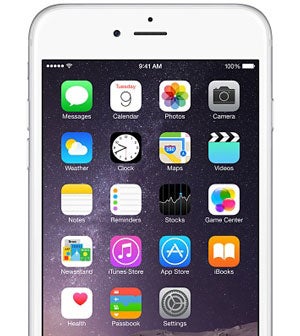 The iPhone 6 is closer than ever to the Samsung Galaxy S5. Where once there was a huge difference in screen size now there’s just 0.4-inches.
The iPhone 6 is closer than ever to the Samsung Galaxy S5. Where once there was a huge difference in screen size now there’s just 0.4-inches.
In terms of ergonomics and design though the iPhone 6 is way ahead of the S5. Made of brushed aluminium it’s just 6.9mm thick compared to the 8.1mm of the Galaxy S5 and feels a whole lot classier in your hand. Touch ID is also a lot easier to use than the fingerprint scanner on the S5, too. If you like phones you can easily use one-handed then the iPhone 6 wins out.
iOS 8 is also a big step up and is a slicker experience than the TouchWiz heavy interface on the S5. The Samsung is more customisable, but the iPhone runs smoother and is easier to use.
That’s where the benefits of the iPhone 6 end. The Galaxy S5 may not feel as premium but it is water resistant, has an outstanding screen (if you choose the right settings) and battery life that stands head and shoulders above Apple’s phone.
Add to that a microSD slot for cheap extra storage, removable battery and a camera that in some cases exceeds the solid snapper on the iPhone 6 and the Galaxy S5 becomes a compelling proposition. That’s before you even factor in that it’s now a lot cheaper.
Read more: Samsung Galaxy S5 vs iPhone 6
Galaxy S5 Compared to LG G3…
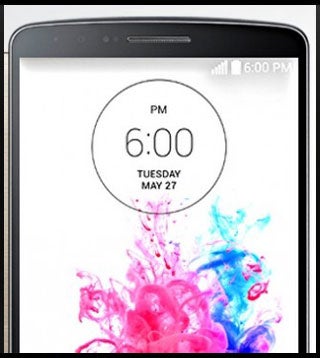 The LG G3 won the TrustedReviews Award 2014 for the best smartphone and gives the Galaxy S5 some serious competition.
The LG G3 won the TrustedReviews Award 2014 for the best smartphone and gives the Galaxy S5 some serious competition.
Just like the Galaxy S5 this is a plastic phone but a thin metallic film on the back cover makes it look and feel slicker than the Samsung. LG have thought a lot about the design and ergonomics of the phone which has led to the power and volume buttons being situated at the back. It might sound mad but you quickly get used to it and it trumps the button locations of the S5 in terms of ease of use.
Both phones pack almost identical specs in terms of processors, but the LG G3 has a higher resolution screen than the Galaxy S5. You shouldn’t be influenced by that too much, though. The Galaxy S5’s display is still super-sharp and has much better brightness and black levels. We prefer the Galaxy S5’s screen to the LG G3 even though it packs fewer pixels.
It’s pretty even when it comes to cameras too. The Galaxy S5 captures more detail, but the laser focusing on the LG means it’s a lot quicker at snapping in low-light conditions.
Final things to consider is that the Galaxy S5 has marginally better battery life and is water resistant.
Read more: Samsung Galaxy S5 vs LG G3
Galaxy S5 Compared to HTC One M8…
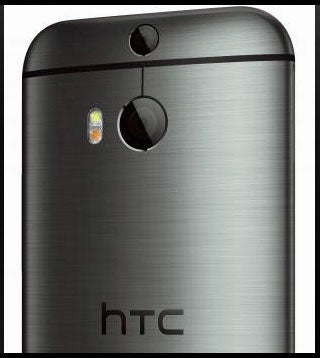 There can be no argument that the HTC One M8 looks and feels a lot better than the Galaxy S5. The metal body and attractive design means there’s little contest. Parts of the M8’s interface also look and feel better, particularly since not every part of the S5’s TouchWiz interface is that well designed.
There can be no argument that the HTC One M8 looks and feels a lot better than the Galaxy S5. The metal body and attractive design means there’s little contest. Parts of the M8’s interface also look and feel better, particularly since not every part of the S5’s TouchWiz interface is that well designed.
The Galaxy S5 might lose out in the looks and design department but it wins in other core elements of the phone – the screen and camera. The OLED display is better in virtually every respect, thanks to Samsung’s fine-tuning of the tech behind it. The HTC One M8 screen isn’t bad, but the S5 really has a best-in-class display.
We also think the S5 camera is better. It’s more reliable and produces far more detailed photos. That said, while both phones have a blurring out effect for portraits and the like, the HTC One M8’s version of it is loads better.
Read more: Galaxy S5 vs HTC One M8
Galaxy S5 Compared to Sony Xperia Z2…
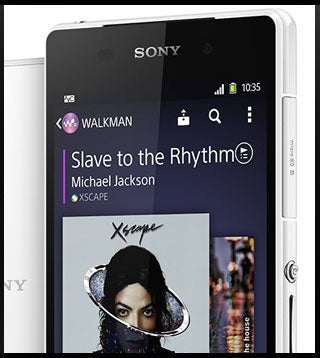 The Xperia Z2 is a little more stylish than the Galaxy S5, but the gap in design isn’t quite as wide as it is with the HTC.
The Xperia Z2 is a little more stylish than the Galaxy S5, but the gap in design isn’t quite as wide as it is with the HTC.
Its glass-on-metal look is a bit less attention grabbing, and much closer in look to its predecessor than the S5, but that slim and severe Xperia look is pretty strong.
The Xperia also offers a bigger battery and slightly better waterproofing. It is certified to withstand water jets and being submerged in water for longer than the S5. However, for most people that’s not really an effective upgrade – who deliberately dunks their phone in water for more than half an hour?
These phones use the same core processor too – but the S5 is clocked a little faster – and the Xperia Z2 has more RAM, 3GB to the Samsung’s 2GB. This should in theory make it slightly better at multitasking. The Xperia also has a higher-resolution camera, and DXOMark rates it as the highest-quality sensor in a mobile although the S5 more than holds its own in this department. However, the Galaxy S5 screen still has the edge for pure image quality.
Read more: Galaxy S5 vs Xperia Z2
Samsung Galaxy S5: Design
Samsung has done its best to make the Galaxy S5 look quite different from the S4. It has a dimpled back, while the Galaxy S4 is smooth and glossy. There is one thing that brings the two phones together, though.
Where the Sony Xperia Z2 and HTC One M8 try to use expensive feeling, or looking, materials throughout, the Galaxy S5 is almost entirely plastic. And it is not plastic that’s happy to look like what it is. The sides of the phone are trimmed with metallic plastic that an onlooker might mistake for metal. But the feel of plastic is unmistakeable in-hand.
The new-design sides are ribbed too, which looks worse than the flat style of the S4. The look is not a wholesale improvement.
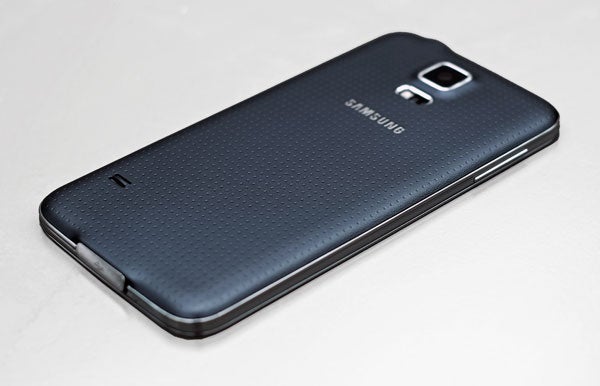
The in-hand feel is better, though. It has a rather unusual, slightly soft-touch textured and pitted finish. This ensures you won’t mistake the Galaxy S5 for any other phone one the market (unless another phone maker nicks this style), but the phone is nowhere near as good-looking as the HTC One M8.
Functionally this back cover style is perfectly fine, though. It won’t leave your purring at the expensive feel of the expensive phone you just bought, but it is grippy and has a soft-touch finish that feels a bit better than Samsung’s old glossy plastic mobiles. The finish is not consistent across the phone’s colours, though – the white Galaxy S5 feels a lot cheaper and less ‘soft’ than the black version, for example.
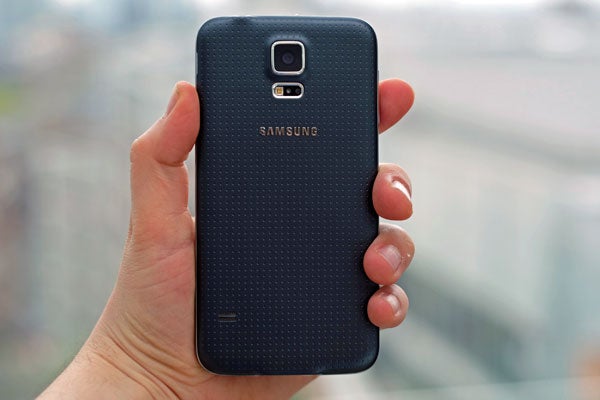
Samsung is likely to offer the Galaxy S5 in a whole rainbow of colours before the phone slips into obsolescence in 2015-2016, but at launch there are four shades to choose from. We’re looking at the black version, which is actually a very dark grey, and the other options are blue, gold and white.
Picking a colour is naturally a personal preference, but having seen them all close-up, gold seems to be the dud. Where Apple and HTC have successfully judged their recent gold models, using a fairly muted ‘Champagne’ shade, Samsung’s has the bling’y vibrance of a £10 plastic handbag. 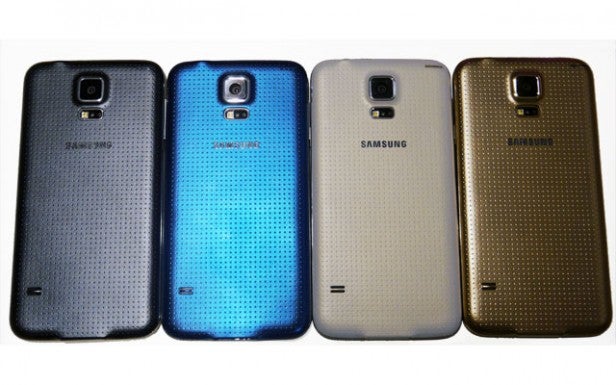
The dimensions of the Galaxy S5 are, as is common for Samsung flagships, impressive. It’s just 8.1mm thick and despite having a slightly larger screen and a load more tech inside, it’s just a couple of millimeters wider than the Galaxy S4. The screen bezel isn’t quite as skinny as the LG G2‘s, but Samsung has put some effort into making such a large screen reasonably easy to use.
To see quite how much bigger the S5 is, check out our Galaxy S5 vs S4 comparison
The Galaxy S5’s power button sits on its right side, in reach of your thumb, and the combo of thin body and reasonable phone width play their part in making the phone easy to deal with. However, as with every 5-inch screen phone, reaching from one end of the screen to the other with a thumb just isn’t going to happen. If you’re thinking of upgrading from an iPhone, you must have a feel first-hand before buying.
There’s also an unfortunate knock-on effect of Samsung’s dedication to making slim phones. The camera lens housing sticks out from the rest of the back by around 0.5-1mm, making it more prone to scratches than a flush one. The Galaxy S4 has this kind of lens arrangement roo. In this case it’s a practical issue caused by having to fit in a 6-element lens camera system into a 8.1mm body, and that’s behind a screen and top glass layer too.
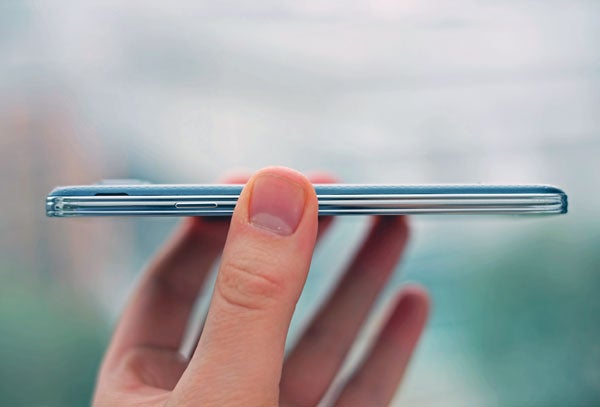
Like the previous Galaxy S phones, the Galaxy S5 uses an ultra-thin removable plastic back cover that hides a microSD memory card slot supporting cards up to 128GB. There are 16GB and 32GB versions of the phone, and the 16GB edition will be by far the most common in the UK.
Samsung has also packed a bunch of new hardware features into the Galaxy S5. The ones we’ll deal with in this section of the review are the water resistance, the fingerprint scanner and the heart rate sensor.
Read more: Samsung Galaxy S5 vs LG G3
Samsung Galaxy S5: Water Resistance
The Galaxy S5’s water resistance works just as it does on other recent water resistant phones. There are rubber seals on the plastic cover and on the flap that sits over the USB port on the bottom. This is one of the few phones to use an oversized micro USB 3.0 socket, also seen in a few other Samsung phones including the Galaxy Note 3, and it makes the bottom flap fairly large.
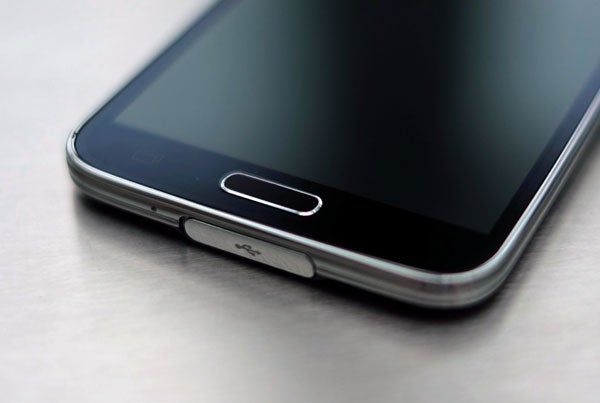
Crucial to the convenience of the water resistant design, the headphone jack doesn’t need a flap as it’s coated internally to avoid letting any water in,
Samsung has managed to add water resistance without any obvious increase in the bulk of phone, and after charging the phone throws up a reminder to close the flap – which is handy (but not dismissable as far as we can tell, and therefore sure to become annoying).
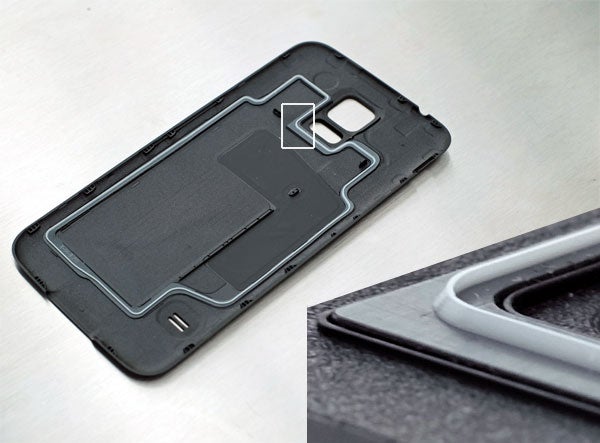
However, there are some slight concerns about the longevity of these ultra-slimline waterproofing systems. The waterproof rubber border is less than a millimeter thick, and feels very slight. It may not last for ever. We like to think of these phones’ waterpoofing as a form of insurance, not an excuse to drop your phone in your pint at every opportunity.
The actual specification of the Galaxy S5’s water resistance is IP67. This means the phone is impervious to dust and can be submerged in water for up to half an hour. This is not quite as good as the IP55 and IP58 ratings of the waterproof Xperia Z2. That phone is certified to stay underwater for longer and withstand water jets. The difference won’t matter for most people, but the key point is that the Galaxy S5 is ‘water resistant’ while the Z2 is genuinely waterproof. Our feature, ‘Waterproof Phones: IP Ratings Explained’, goes into a great deal more detail on the topic.
Samsung Galaxy S5: Fingerprint Scanner
Samsung’s new fingerprint scanner is more interesting. We’ve seen a few different fingerprint scanners in mobiles over the last 12 months. The iPhone 5S’s TouchID is a great success, the HTC One Max‘s rear scanner a flop.
The Galaxy S5 sits in a similar position to the iPhone scanner, but it isn’t quite as slick, although it is better than the scanner in the HTC One Max.
Rather than resting your finger over the button, as with an iPhone 5S, you swipe a finger over it. The sensor sits under the central select button, but you need to swipe over the very bottom of the touchscreen too as there’s an element under the screen that activates the scanner.
You can teach the Galaxy S5 up to three fingers, letting multiple people get on-board.
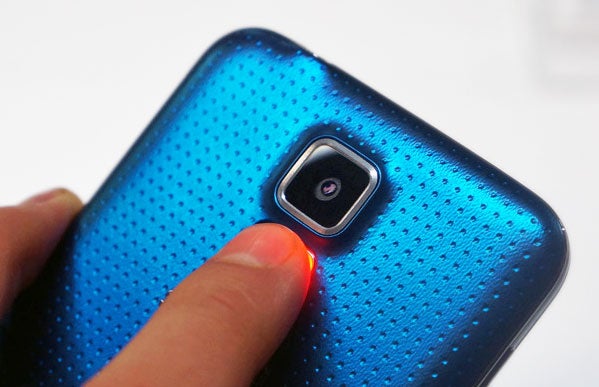
The Trusted team has had mixed experiences with the fingerprint sensor, but I didn’t find it particularly easy to use. A swipe-based mechanism like this requires quite an exact, smooth movement, and this is at odds with the casual, care-free way most of us use our phones. Compared with the iPhone 5S TouchID sensor, it’s a bit of a pain.
To call upon a metaphor, where the TouchID sensor asks you to stand still, the S5 scanner demands you walk in a dead straight line. And that’s fine at times, but not when you’re in a rush, have just woken up or are inebriated and desperate to find out when the last train home leaves.
After the Galaxy S5 has failed to recognise your fingerprint three times, you’re booted out to a more traditional password. And I had to use this password more often than not for the first few days. The performance boosted a little after the scanner was recalibrated a few times, but at best the hit rate was about 50 per cent.
If you want to do more research on the fingerprint sensor, it’s based on Synaptics Natural ID technology. For more detail, read our Galaxy S5 Fingerprint Scanner vs iPhone 5S Touch ID comparison.
Samsung Galaxy S5: Heart Rate Sensor
Perhaps the most conspicuous of the new hardware elements is the dedicated heart rate sensor, because it adds new sensors to the LED flash area on the back of the phone. The camera area on the pack looks positively gadget-packed now.
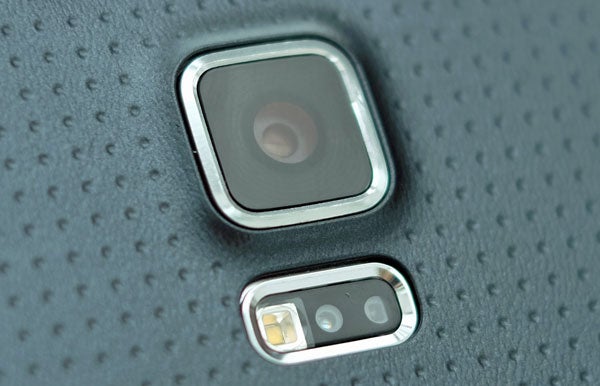
This is the first phone to use a dedicated heart rate sensor, but it uses fairly familiar technology. It lights-up your finger with a red/IR light, and monitors the visual changes caused by the circulation of your blood.
It works well, and takes about eight seconds, but there are two obvious questions – is it actually useful, and can you get this functionality elsewhere? At present, you can only use the Galaxy S5’s heart rate sensor in the S Health app (although it appears to be part of the Samsung Bluetooth LE SDK, so should be able to be used in third-party apps), where it makes a graph of your previous results.
It will come in handy for measuring your resting heart rate, which is a reasonable indicator of general fitness levels. But it’s not much cop for mid-exercise readings, where it would be of more use. Quite simply, holding your finger on the back of the Galaxy S5 while running is not a good idea. For that you really want a wrist-worm device like the Galaxy Fit.
In truth, you can already get a very similar experience with most other Android phones (and iPhones) too. Apps like Runtastic Heart Rate use your phone’s LED flash and camera sensor in much the same way. And with the HTC One M8, our tests showed they provide similar results in a similar time frame.
The Galaxy S5 heart rate sensor is less interesting than it initially appears.
Samsung Galaxy S5: Why all the extras?
We’re not huge fans of the heart rate sensor or the fingerprint scanner. The waterproofing deserves a nod, but why has Samsung put such a focus on these hardware ‘extras’ this year?
It becomes obvious when you look at the phone’s other specs. Smartphones have plateau’d technologically – it might be temporary, but it affects all the early 2014 flagships. Samsung can’t fit in a much larger screen without affecting how it feels to use, the screen is still at 1080p resolution and the Snapdragon 801 processor used here isn’t that much more powerful or advanced than the Snapdragon 800 used in some of last year’s phones.
Samsung clearly felt the need to put conspicuously ‘new’ hardware in the Galaxy S5. And some of it is not that good. Yet. This need to separate the Galaxy S5 from the Galaxy S4 in obvious ways also helps to explain slightly odd pitted finish.
Samsung Galaxy S5: Internal Speaker
We would gladly trade away most of these supposed hardware innovations for a better internal speaker. But this is something that – once more – has been relatively neglected by Samsung.
Sound pipes out of a single grille under the backplate, and uses the limited internal area between the outer parts of the cover and the zone blocked off by the rubber seals to somewhat reinforce the sound (to act as a speaker enclosure of sorts).
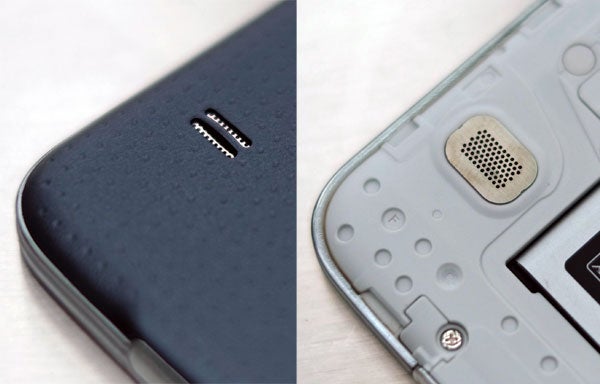
We have heard worse speakers, and the Galaxy S5 can handle its own top volume without distorting significantly. But the sound is pretty tinny and bass-free. Coming from reviewing the HTC One M8 – which has relatively chunky-sounding stereo speakers – it’s a depressing step down. And we’d wager only those with health-themed OCD would prefer a very limited-use heart rate sensor to a decent set of speakers.
The speaker also causes fairly severe vibration in the lower part of the phone’s rear. It’s the result of essentially using the outer casing as a speaker enclosure, and it is a bit annoying.
How we test phones
We test every mobile phone we review thoroughly. We use industry standard tests to compare features properly and we use the phone as our main device over the review period. We’ll always tell you what we find and we never, ever, accept money to review a product.


